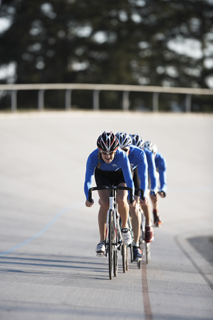Using Indoor Cycling to Become Better Outdoors

It is no great secret that indoor cycling, also known as spinning, can benefit all types of athletes. Unfortunately, many people still treat indoor cycling as a last resort when the weather is bad, even though spinning allows you to focus on every aspect of your cycling movement in great detail, helping you control each feature of your workout to meet specific objectives.
However, one of the worst things you can do when practicing indoor cycling is to learn in a class with someone who is not a real bike rider, but rather a spinning teacher who is actually an aerobics instructor. These classes are often greater calorie burners but have little to do with real cycling, often involving extraneous workouts like "jumps" — popping up and down out of the saddle — and pushups on the handlebars.
As an outdoor cyclist, you may be better off acting as your own coach through your knowledge of body position, hill climbing, and how to engage the hamstrings and calves, not just the quads.
When cycling indoors, you should aim to focus on two main training elements: speed and climbing. Here are a few ideas as to how you can do so:
Speed
You can make huge gains to your cycling speed outdoors by practicing a couple of specific techniques indoors. To build your explosive power and raise your lactate threshold, AdventureCORPS recommends practicing standing speed work. To do so, keep your body tall and straight, stabilizing your upper body through your abs while using your fingertips for balance on the handlebars. Then stand up and run on the pedals, putting all of your body weight on your quads. Using this technique, you should be able to bring your cadence up to 200 rpm.
You can also work on your speed by sitting and building up your rapid turnover. With little resistance, sit forward in the saddle and stabilize your hips and upper body using your abs. Once again, aim to reach 200 rpm.
Climbing
Indoor cycling helps you learn to get better use of all the muscles in your legs, not just the quads; for instance, standing climbing will allow you to train your hamstrings, glutes, and back muscles. In outdoor hill climbs, the front end of the bike is tipped up, so you need to replicate this position while spinning. Hinge at the hips, keep your back straight and parallel to the ground, and keep your nose just a few inches above the handlebars.
Here is an idea for an intense climbing workout from Active:
Begin with a 15-minute warm-up consisting of five minutes of spinning at Zone 1 intensity, five minutes of alternating legs (30 seconds per leg before switching) at Zone 1 to 2, and then five minutes of spinning at 90 rpm at Zone 1 to 3.
For the main exercise, start with a seated climb at Zone 2 to 3 for three minutes followed by a one-minute recovery. Then, decrease the length of the seated climb to just two minutes, but work at Zone 4 to 5. After another one-minute recovery of easy spinning, work at Zone 4 to 5 in a seated climb for just two minutes followed immediately by a standing climb for one minute.
Gradually increase the amount of time on your standing climb: the next interval will be 1:30 minutes seated and 1:30 minutes standing, then one minute seated and two minutes standing, next 30 seconds seated and 2:30 minutes standing, and finally three minutes standing. Finish the workout with seven minutes of easy spinning in Zone 1.
It may seem like a lot of work at first, but incorporating some of these workouts into your indoor cycling routine will help advance your speed and climbing capabilities just in time for that next outdoor cycling challenge.

